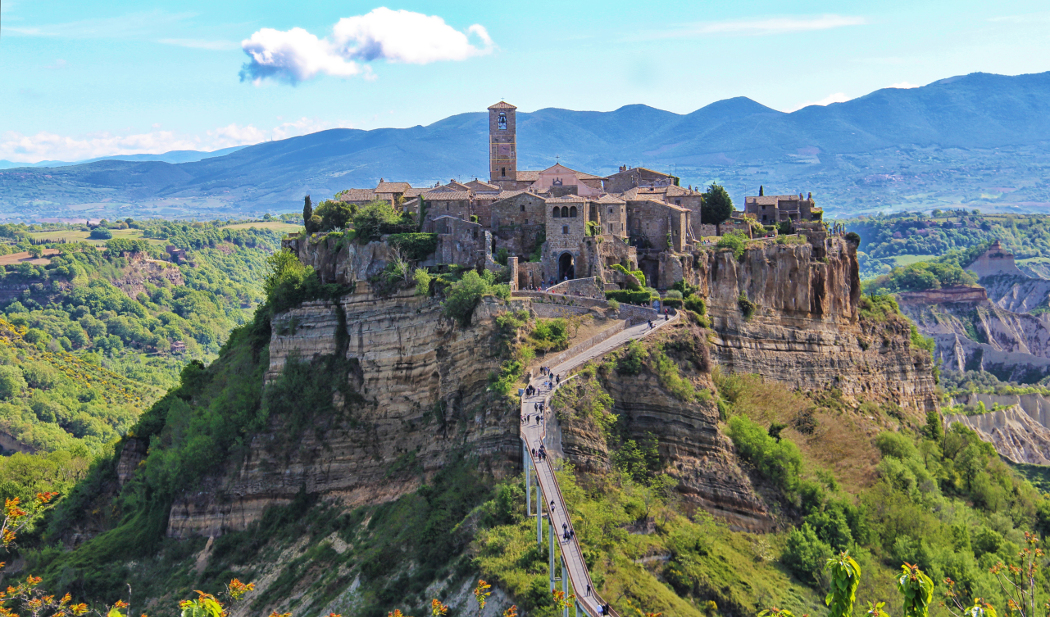|
Civita di Bagnoregio, the dying town
You can find all the updated news about timetable,
tickets, tours and much more on the official site
Civita di Bagnoregio.
About an hour's drive from Frallarenza in the direction of Viterbo, the medieval village of
Civita di Bagnoregio looks like an unreal landscape, created by the gradual subsidence of the
land and the erosion of the spur of tufa where resists, a handful of perched
and isolated houses, now reachable only by foot through a concrete bridge
about 300 meters long.
Civita is an enchanted place where time does not seem to roll over.
The total absence of cars makes the atmosphere within Civita even more
unreal.
The remains of the village, once the political and religious center
of Bagnoregio, are all along the only road that crosses the entire town:
Porta St. Mary, the Cathedral of St. Donato, until 1699 Bagnoregio Cathedral,
the elegant Palazzo Mazzocchi-Alemanni, Palazzo Bocca.
But the real work of art is the landscape that surrounds the rock, to
whose charm the visitor can not steal. The nature, that made so uncertain
the future of the village, has eroded and shaped the clay hills, once
smooth and accessible, surrounding the town to turn them into extraordinary
natural sculptures. On the eastern end of Civita you can best admire
the magnificent scenery of the Valley of Calanchi.
Brief History:
the city was founded by the Etruscans 2500 years ago on a cliff of tuff
chosen for his very defensible position.
• VI sec. first documentation on Bagnorea (this
is the oldest name), mentioned among the bishops places of Italy. After
the fall of the Roman Empire, Bagnoregio falls under the dominion of
the Goths and Lombards, Charlemagne finally gave it to the papacy. Afterwards
the power was exercised by a succession of different feudal gentlemen;
between these Monaldeschi, which later became the lords of Orvieto.
• XII sec. Bagnoregio becomes a free municipality
and have a period of prosperity and cultural vitality. Even if it is
attracted into the nearby and powerful Orvieto, can still maintain a
degree of autonomy.
• 1221 St. Bonaventure was born in Bagnoregio.
• 1348 an epidemic of plague (described in the
Decameron by Boccaccio) decimates the town, it is said that in a single
day there are more than 500 dead.
• 1494 the exasperated inhabitants of Bagnoregio
rise in a violent rebellion that led to the destruction of the castle
of Cervara, from which the Monaldeschi had exercised their power for
more than a century. In memory of these events two basalt stone lions
were walled up above the port of Santa Maria, holding human heads between
their legs in memory of the victory of the people of Civita.
In the same year inhabitants of Bagnoregio are opposed to entry in the
city of King Charles VIII of France, led to Naples with his army.
Two years after Pope Alexander VI Borgia deal a hard blow to the proud
feeling of freedom by setting up the municipal system of cardinal-governors,
which would last until 1612, when Bagnoregio come under control with
the Apostolic Delegation of Viterbo.
• 1695 A first earthquake, in addition to destructive
erosion, causes enormous damage to the town of Civita.
• 1794 A second earthquake in 1794 destroys the
narrow natural bridge that connects Civita to the outer suburb of Rhota.
At that point, most of the people leave the old village and settle at
Rhota, the suburb born in the thirteenth century, which is now the center
of Bagnoregio.
• 1867 the first violent clash between the papal
militia and garibaldi volunteers goes down in history as "the battle
of Bagnorea." In 1870 Bagnoregio enters the Kingdom of Italy.
|






